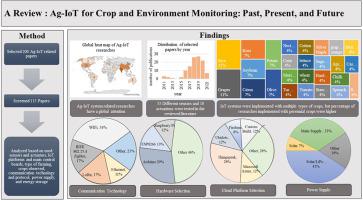Agricultural Systems ( IF 6.1 ) Pub Date : 2022-09-13 , DOI: 10.1016/j.agsy.2022.103497 Nipuna Chamara , Md Didarul Islam , Geng (Frank) Bai , Yeyin Shi , Yufeng Ge

|
CONTEXT
Automated monitoring of the soil-plant-atmospheric continuum at a high spatiotemporal resolution is a key to transform the labor-intensive, experience-based decision making to an automatic, data-driven approach in agricultural production. Growers could make better management decisions by leveraging the real-time field data while researchers could utilize these data to answer key scientific questions. Traditionally, data collection in agricultural fields, which largely relies on human labor, can only generate limited numbers of data points with low resolution and accuracy. During the last two decades, crop monitoring has drastically evolved with the advancement of modern sensing technologies. Most importantly, the introduction of IoT (Internet of Things) into crop, soil, and microclimate sensing has transformed crop monitoring into a quantitative and data-driven work from a qualitative and experience-based task.
OBJECTIVE
Ag-IoT systems enable a data pipeline for modern agriculture that includes data collection, transmission, storage, visualization, analysis, and decision-making. This review serves as a technical guide for Ag-IoT system design and development for crop, soil, and microclimate monitoring.
METHODS
It highlighted Ag-IoT platforms presented in 115 academic publications between 2011 and 2021 worldwide. These publications were analyzed based on the types of sensors and actuators used, main control boards, types of farming, crops observed, communication technologies and protocols, power supplies, and energy storage used in Ag-IoT platforms.
RESULTS AND CONCLUSION
The result showed that 33 variables measured by various sensors were demonstrated in these studies while 10 actuations were successfully integrated with Ag-IoT platforms. Perennial crops, which introduced less disturbance to Ag-IoT platforms than annual crops, were selected by 64% of researchers. Furthermore, studies in Ag-IoT system development were more focused on outdoor than indoor environments. Ag-IoT systems based on Arduino were most common among the studies while commercial platforms were least adopted, likely due to their inflexibility in customized developments. More researchers focused on agricultural applications than the IoT technology itself. Soil water content-based irrigation scheduling and controlled environment monitoring and controlling were the main applications. Other application areas included soil nutrient estimation, crop monitoring based on multiple vegetation indices, pest identification, and chemigation.
SIGNIFICANCE
Several potential future research directions were identified at the end of the review, including integration of satellite-based internet connectivity to improve the IoT networks in non-connected farms, development of mobile IoT platforms (drones and autonomous ground vehicles) with continuous connectivity, and the use of edge-computing and machine-learning/deep-learning to enhance the capability of the Ag-IoT systems.
中文翻译:

用于作物和环境监测的 Ag-IoT:过去、现在和未来
语境
以高时空分辨率自动监测土壤-植物-大气连续体是将劳动密集型、基于经验的决策转变为自动化、数据驱动的农业生产方法的关键。种植者可以通过利用实时现场数据做出更好的管理决策,而研究人员可以利用这些数据来回答关键的科学问题。传统上,农业领域的数据采集在很大程度上依赖于人工,只能生成有限数量的数据点,分辨率和准确性较低。在过去的二十年里,随着现代传感技术的进步,作物监测发生了巨大的变化。最重要的是,将 IoT(物联网)引入作物、土壤、
客观的
Ag-IoT 系统为现代农业提供数据管道,包括数据收集、传输、存储、可视化、分析和决策。该评论可作为农业物联网系统设计和开发的技术指南,用于作物、土壤和小气候监测。
方法
它重点介绍了 2011 年至 2021 年间在全球 115 种学术出版物中提出的 Ag-IoT 平台。这些出版物的分析基于所使用的传感器和执行器的类型、主控制板、农业类型、观察到的作物、通信技术和协议、电源以及 Ag-IoT 平台中使用的能量存储。
结果与结论
结果表明,在这些研究中展示了由各种传感器测量的 33 个变量,而 10 个驱动成功地与 Ag-IoT 平台集成。64% 的研究人员选择了对 Ag-IoT 平台的干扰比一年生作物更少的多年生作物。此外,Ag-IoT 系统开发的研究更侧重于室外环境而不是室内环境。基于 Arduino 的 Ag-IoT 系统在研究中最为常见,而商业平台的采用率最低,这可能是由于它们在定制开发中的不灵活性。与物联网技术本身相比,更多的研究人员关注农业应用。基于土壤含水量的灌溉调度和受控环境监测是主要应用。其他应用领域包括土壤养分估算、
意义
审查结束时确定了几个潜在的未来研究方向,包括集成基于卫星的互联网连接以改善非连接农场的物联网网络,开发具有连续连接性的移动物联网平台(无人机和自动地面车辆),以及使用边缘计算和机器学习/深度学习来增强 Ag-IoT 系统的能力。











































 京公网安备 11010802027423号
京公网安备 11010802027423号